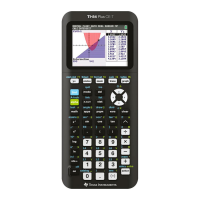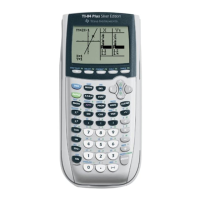strings should be very modular, and your program should provide an option to delete the help
system, since this uses up RAM very quickly. In this way, inexperienced users get the help they
need to run your program, and they can remove it when they don't need it anymore.
! Set the application's folder within the program itself. This makes sure that all subprograms,
functions and variables are available while the program is running. When the program exits, restore
the folder so that the user doesn't have to, and isn't surprised to be in a different folder.
! Use local variables if at all possible. However, you will be forced to use global variables in some
cases. Use DelVar to delete these automatically when the program exits. If you think that the user
might want to keep them, give her the option to delete them when the program exits.
! If your program uses matrices or other data structures, it is most likely that those are not in the
application's folder. So, when you prompt for the variable name, make sure that the user knows that
he needs to enter the folder name, as well. Sometimes I prefer two separate Request statements,
one for the folder name, and one for the variable name. Your program needs to be able to refer to
variables by both the folder name and the variable name.
! If your program creates large data structures, check available memory with getConfg() before
creating the variable. If there isn't much free RAM, warn the user.
! If your program uses large data structures, think about archiving them automatically, so they don't
use so much of the calculator's RAM. If your program only needs to read from the data structure, it
can remain permanently archived. However, if the program needs to write to the data structure, you
will need to unarchive it, perform the write operation, then archive it again. If you try this approach,
make sure that your program cannot execute a loop in which the variable is rapidly and repeatedly
archived. In extreme cases this will 'wear out' the archive flash memory.
! Provide an 'exit' or 'quit' menu item in your program. This gives the program a chance to delete
global variables, restore the mode settings, and restore the folder.
! If your program displays output on the program I/O screen, use DispHome when the program exits.
This means the user doesn't have to press [green diamond] HOME to get back to the home screen.
! Consider providing a menu to let the user set the number display digits and exponential mode, for
numeric results. Use format() to display the results based on the user's choice. In large programs
with lots of output, I even let the user set different formats for different sets of variables.
! If possible, use functions and commands that are available on both the original 92 as well as the
89/92+. This means that more people can use your program. However, this is a common dilemma
encountered whenever hardware and software improves. In some cases, this means that users with
the newer systems pay a penalty in terms of execution speed or code size.
! Keep in mind that there are two broad types of users. The first type just wants an answer from your
program from the command line, as quickly and easily as possible. This user needs dialog boxes to
prompt for the inputs, and clearly labeled output. The second type of user might want to use your
code in her own programs. This user wants your code as a function, not a program, so it can be
easily called, and return its results to the user's program. One clean way around these conflicting
requirements is to encapsulate your core functionality as a function, and supply an additional
interface routine that provides prompts and labelled output.
! Provide documentation for your program. You might have written the greatest program in the history
of coding, but if people can't figure out how it works, you might as well have saved yourself the
effort. The documentation doesn't need to be a literary work of art.
In the end, it is your program, and you'll write it the way you want to. And writing a robust, efficient
program is a lot of work. It is likely that if you use all of these suggestions, the amount of code needed
to make the program a pleasure to use will be far greater than the code to actually do the work!
Depending on the program, it might not be worth the effort. You just have to use your judgement.
9 - 3
